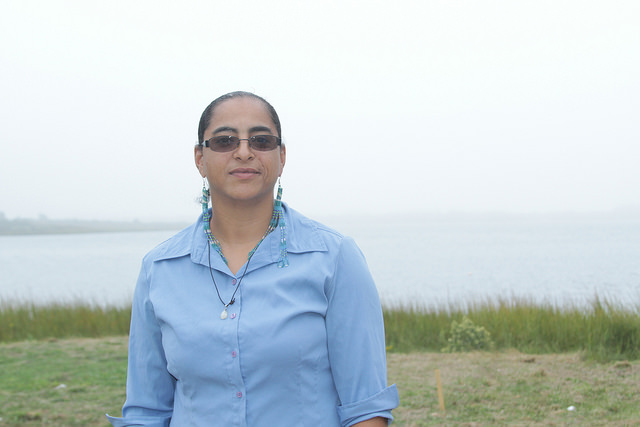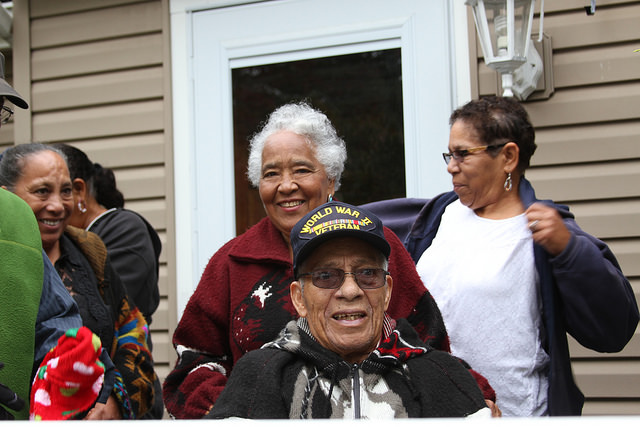“Tribal communities are really on the front lines of climate change.” Those were the opening words of U.S. Interior Secretary Sally Jewell to a gathering of Shinnecock Tribal leaders, press and GRID Alternatives staff during GRID’s Tribal Solarthon event last Thursday. Her words could not have been better placed. Few communities are closer to the front lines of climate change than the Shinnecock, a 10,000-year-old tribe on the eastern end of Long Island. With just about 1000 acres of land remaining in its name, the Nation is losing feet of precious coastline every year to rising sea levels, and saw parts of its ancestral graveyard swept away during Superstorm Sandy.
“As indigenous people we say we are the miner’s canary,” said Kelsey Leonard, a Shinnecock and Oxford University graduate who serves on the tribe’s natural resources committee. “In terms of climate change and globalized policies that are going to affect us and the world, we are the first ones hit, and will continue to be hit.”
This daily reality has made stewardship of their land and resources a pressing priority for this small nation of around 1500 people, and how they produce energy is an increasingly important part of that. In 1979, the Shinnecock’s oyster hatchery was one of the region’s first solar-powered businesses; Today, the Nation is partnering with GRID Alternatives to bring solar power to Tribal homes and eventually a battery back-up system on the community center that will provide power during the kinds of weather and other emergencies that community members hope will never come again.
 “After Sandy, there were some damaged buildings and some water quality issues, but one of the biggest things was lack of electricity,” said Ms. Leonard. “It would have been nice to be off the grid so we could get back up and running faster. We were totally dependent on [the local utility], and it took almost three weeks to get power back. Families were living on generators and waiting in gas lines for six hours.”
“After Sandy, there were some damaged buildings and some water quality issues, but one of the biggest things was lack of electricity,” said Ms. Leonard. “It would have been nice to be off the grid so we could get back up and running faster. We were totally dependent on [the local utility], and it took almost three weeks to get power back. Families were living on generators and waiting in gas lines for six hours.”
The partnership with GRID is just a start. Only two homes were able to get solar last week as GRID and the Tribe continue to look for funding for the community center system and an additional 48 homes, but it’s an important step forward for the community.
“Tribal Nations stand on the forefront of alternative government and alternative ways of building, developing and maintaining sustainable communities,” said Sequoyah Hunter-Cuyjet, a Shinnecock member and graduate student in design at Moore College who is helping the Nation create a sustainability plan as part of her Master’s thesis. “Shinnecock is small enough and contained enough that it could go completely solar.”
“The nation has been steadily marching toward being economically sustainable, and energy independence is part of that,” said Shinnecock Tribal Chairman Bryan Polite, who said the Tribe is also considering putting large-scale wind, solar or other power generating facilities on its property both to power the community and contribute to Long Island’s overall energy mix.
Tribal elders Marion and James Phillips were selected by lottery to be among the first recipients through GRID’s program. Mr. Phillips, a 90-year-old WWII Veteran, is in a wheelchair, and the couple pays around $170 a month for electricity in one of the nation’s most expensive power markets. Their system is expected to cut their bills by half or more.
 “I could really do a lot with that,” says Mrs. Phillips of her savings. Now in her 80s, she spent 23 years managing a school cafeteria in neighboring Southampton, and helped raise “all the Shinnecock children,” including her five children, nine grandchildren, 14 greats and now one great great.
“I could really do a lot with that,” says Mrs. Phillips of her savings. Now in her 80s, she spent 23 years managing a school cafeteria in neighboring Southampton, and helped raise “all the Shinnecock children,” including her five children, nine grandchildren, 14 greats and now one great great.
Housing costs are a huge challenge for tribal families, who are unable to access mortgage loans for homes on land that is tribally owned. Most residents, especially older ones, live below the poverty line, and younger members leave the community for schooling and jobs in nearby New York, New Jersey and Philadelphia.
“The cost of living is so high and employment opportunities are so few,” explained Sienna Hunter-Cuyjet, Executive Director of Tribal Operations, noting that even renting outside the reservation is challenging because so many homes are used as resort rentals during the summer season and become cost-prohibitive. “People do often need to leave to get an education and find work.”
But many of them stay deeply engaged, and as a result the Tribe has been able to draw on an increasingly educated and experienced generation to help address challenges it is facing, from making housing more affordable to building its climate resiliency.
Coastal restoration has been a top priority in recent years. In the 1990s, the solar-powered oyster hatchery was shuttered after toxic tides caused by excess nutrients swept through its spawning grounds and made the local waters uninhabitable. It was a blow to the Tribe both economically and environmentally, and the hatchery lay dormant for many years. Recently, however, the tribe has begun rebuilding the local oyster population less as an economic engine than as a way to restore the diversity of its coastal ecosystem.
“Since we brought the oysters back we’ve seen seals, turtles and all kind of birds come back,” said Viola Cause, who works in the tribe’s environment department. “Even the green heron, which until recently we had only heard about.”
Superstorm Sandy was a set-back to that effort, but the Tribe is continuing to push forward. With the help of Federal Sandy recovery funds, they have also launched a new effort to rebuild their beaches and prevent further erosion by importing sand from elsewhere in the bay and planting native grasses.
“When you live so close to the ocean and its part of your identity, we see these things and know these things and really are on the front lines,” said Ms. Leonard. “Hopefully the little bit we can do can help everyone else along the way.”
Check out more photos from the event here.
****
From September 28 to October 9, GRID Alternatives is partnering with four Native American tribes in four states for our Tribal Solarthon, providing solar power and solar job training to tribal residents and putting a spotlight on energy and economic issues in their communities. GRID has partnered with over 30 tribes since 2010, installing solar electric systems for more than 330 tribal member families—1.5 MW of clean power—and trained nearly 200 tribal members in solar installation. We formally launched our national tribal program in 2014 with a long-term goal of building permanent infrastructure to make solar power and job training accessible to tribal communities throughout the US.
The Solarthon event is sponsored by Wells Fargo Foundation through a five-year, $2 million national expansion grant awarded to GRID Alternatives in 2012. Additional funders include the Department of Energy and GRID Alternatives equipment partners SunEdison, SunPower Corp., Enphase Energy, SnapNrack and IronRidge.
